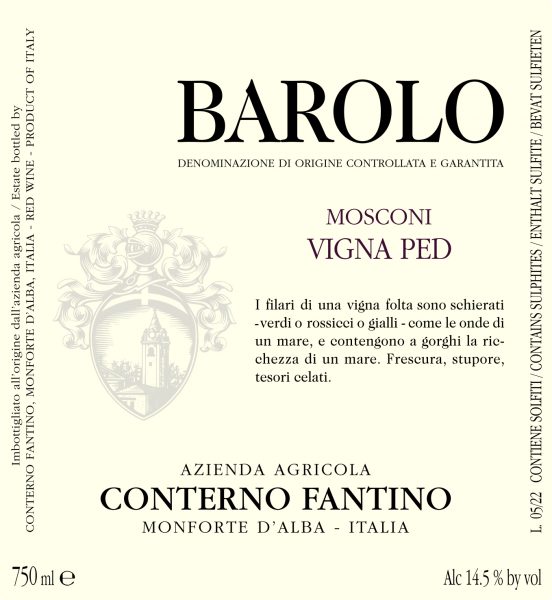- Nebbiolo from ‘Vigna Ped,’ a single, historical vineyard located in the Mosconi cru in Monforte d’Alba
- Planted in 1960, the vines sit at approximately 400 m (1,310 feet) elevation and face south, southeast
- Soils are a mixture of sand, silt, and clay
- An addition parcel, planted in 1999, was selected from the best-performing clones in order to maintain the vineyard’s unique integrity and character
- Hand harvesting begins mid October
- Fermentation and maceration in stainless steel for 12 to 15 days
- Aging in French oak barrels
- First vintage was 2004
- Approximately 330 to 500 cases produced annually
Info
Producer:
Vintage:
2020
Country:
Italy
Region:
Piedmont
Appellation:
Barolo
Variety:
Nebbiolo
Color:
Red
Sizes Available
| Full Bottle | IT-CFA-23-20 | 6/750ml |
Resources
Press & Reviews
James Suckling
Score
95
Date
2024-01-17
"This exceptional wine is deep and dusky, packed with mineral, floral and savory notes that will blossom with time. It shows iron, iodine and rose petals in the nose, then lithe tannins wrap up cranberries, bitter orange, and sour cherry. Best from 2028."
Vinous
Score
96
Date
2024-01-04
"The 2020 Barolo Mosconi Vigna Ped is the most potent and tannic of these wines, but it retains the mid-weight signature of the year and the more nuanced style that is the norm these days at Conterno-Fantino. Dark, ample and broad on the palate, the 2020 offers up a beguiling mix of dark fruit, leather, tobacco, incense, licorice and dried herbs. The 2020 is a complex, dynamic wine that constantly changes in the glass. It should provide exceptional drinking for the next 15-20 years. This is classic Mosconi."
Wine Advocate
Score
94
Date
2024-04-04
"The Conterno Fantino 2020 Barolo Mosconi Vigna Ped has aromas of brandied cherry, Luxardo cherry liqueur, oak toast, licorice root and dark rye. This Barolo is relatively tight in terms of its texture, with good intensity, chalky tannins and sufficient fruit to stand up to the tannins. Fruit comes from a one-hectare site with a combination of sand, silt and clay. Production is 6,000 bottles."




